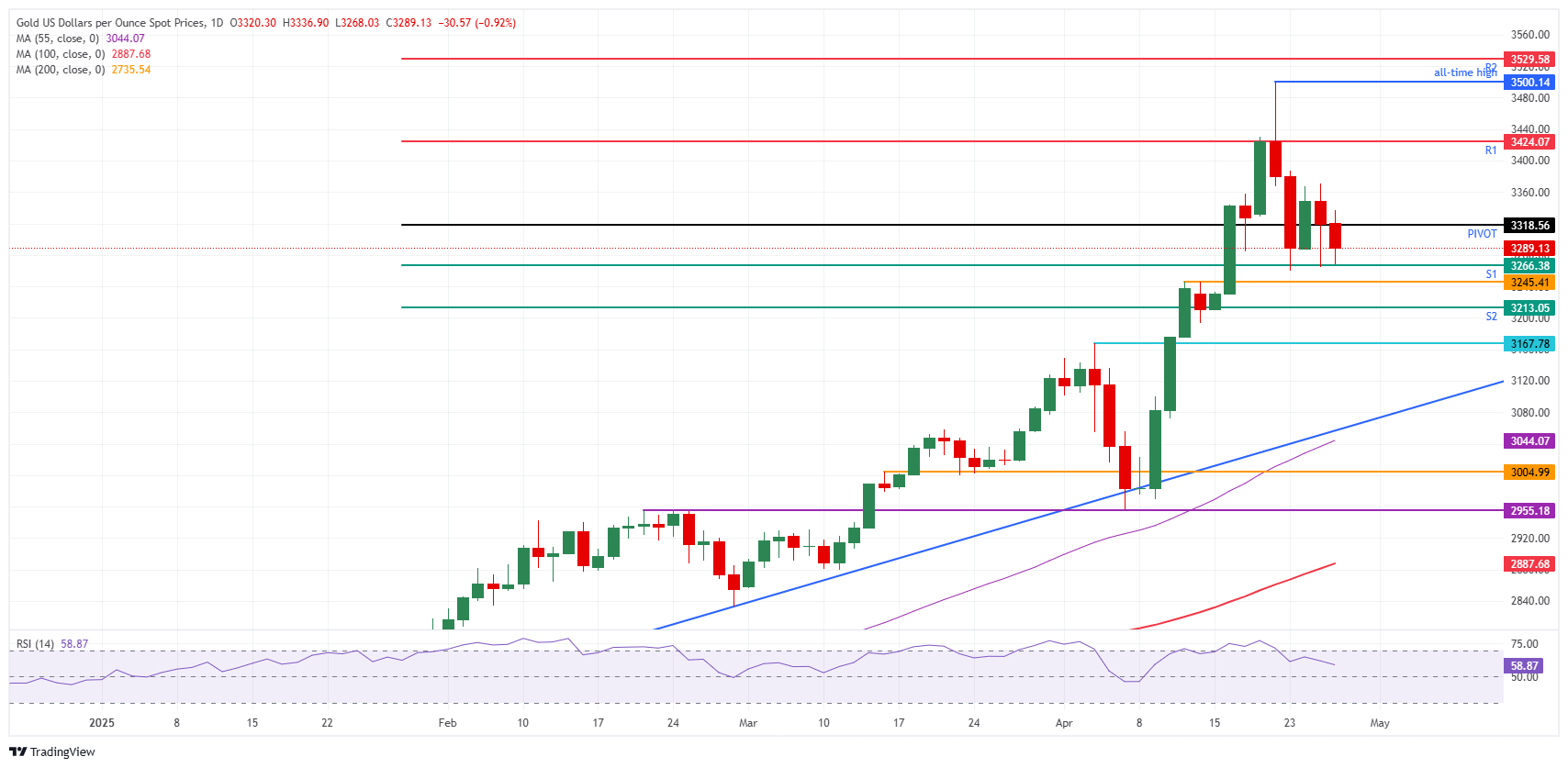Gold looks heavy after Bessent and Rollins confirms trade deal offers are piling up
- Gold price flirts with 1% loss on Monday as traders reduce their tariff hedge trade in Gold.
- US Treasury Secretary Bessent commented that several deals are on the table with several Asian countries.
- Gold eases as traders brace for potential deals in Asia and other countries with the US, reducing tariff risk.
Gold price (XAU/USD) is ticking lower under some profit taking, trading around $3,290 at the time of writing on Monday. The correction comes after a television interview at ABC with United States (US) Treasury Secretary Scott Bessent on Sunday, who mentioned that several big deals were on the table with Asian countries. “If there are 180 countries, there are 18 important trading partners, let's put China to the side, because that's a special negotiation, there's 17 important trading partners, and we have a process in place” said Bessent, and added “some of those are moving along very well, especially with the Asian countries.”
Additionally, US Agriculture Secretary Brooke Rollins said on Sunday that the Trump administration is having daily conversations with China over tariffs, per Reuters. Rollins noted ongoing talks between the two nations and that trade deals with other nations were “very close.” It appears that more easing in the tariff story could be underway, which takes the wind out of the Gold surge.
However, Gold’s price decline could be limited as the Chinese Foreign Ministry reiterated on Monday that President Xi Jinping and US President Donald Trump did not have a call recently. “The US and China have not conducted negotiations or consultations on tariffs,” the Ministry noted.
Looking ahead to the rest of the week, the focal point will be on the April Nonfarm Payrolls (NFP) release on Friday. The US data as a whole will draw much more attention as a barometer to assess the next step of the Federal Reserve (Fed), with the Federal Open Market Committee (FOMC) delivering its next interest rate decision on May 7. The US data last week already started to show signs of a shift, with, for example, Durable Goods revealing a substantial change in consumer sentiment.
Daily digest market movers: Focus on Panama in trade and tariffs
- Toubani Resources, an African Gold miner capitalised at $61 million on the Australian Securities Exchange (ASX), is trading up after securing commitments for a hefty $160 million debt package in a joint venture alongside a family office, Financial Review reports.
- Thailand’s bond market is on course for its best monthly inflows in more than three years, helped by interest-rate-cut bets and a stronger baht due to surging Gold prices, Bloomberg reports.
- China is stepping up scrutiny of Hong Kong billionaire Li Ka-shing’s plans to sell its Panama ports to a BlackRock Inc.-backed group, while US President Donald Trump sought preferential treatment for US ships in the waterway, adding to uncertainty over whether the blockbuster deal will proceed.
Gold Price Technical Analysis: Support to hold
Although Bullion is softening again this Monday, traders and analysts are still calling out that more upside is possible for the precious metal. Despite several trade deals being on the table and negotiations underway, US President Trump mentioned on Friday that a delay on the exemption of tariffs is not being discussed at this moment. Meanwhile, the rhetoric between China and the US is not showing signs of actual talks taking place after Chinese retailer Shein lifted its prices for the US markets by more than 100% to pass on the tariff import costs too the US customer.
The daily Pivot Point at $3,318 is the first hurdle that needs to be recovered this Monday. From there, it is quite a stretch to $3,424 for hitting the R1 resistance. The all-time high at $3,500 will be a firm cap on the upside, which makes the R2 resistance at $3,529 a near-implausible level to reach this Monday.
On the downside, the S1 support is providing a cushion at $3,266, roughly converging with last week’s low of $3,260. Further down, the technical pivotal floor near $3,245 (April 11 high) comes into play. Finally, the S2 support at $3,213 should prevent any further downturn to the pivotal level at $3,167 (April 3 high).

XAU/USD: Daily Chart
US-China Trade War FAQs
Generally speaking, a trade war is an economic conflict between two or more countries due to extreme protectionism on one end. It implies the creation of trade barriers, such as tariffs, which result in counter-barriers, escalating import costs, and hence the cost of living.
An economic conflict between the United States (US) and China began early in 2018, when President Donald Trump set trade barriers on China, claiming unfair commercial practices and intellectual property theft from the Asian giant. China took retaliatory action, imposing tariffs on multiple US goods, such as automobiles and soybeans. Tensions escalated until the two countries signed the US-China Phase One trade deal in January 2020. The agreement required structural reforms and other changes to China’s economic and trade regime and pretended to restore stability and trust between the two nations. However, the Coronavirus pandemic took the focus out of the conflict. Yet, it is worth mentioning that President Joe Biden, who took office after Trump, kept tariffs in place and even added some additional levies.
The return of Donald Trump to the White House as the 47th US President has sparked a fresh wave of tensions between the two countries. During the 2024 election campaign, Trump pledged to impose 60% tariffs on China once he returned to office, which he did on January 20, 2025. With Trump back, the US-China trade war is meant to resume where it was left, with tit-for-tat policies affecting the global economic landscape amid disruptions in global supply chains, resulting in a reduction in spending, particularly investment, and directly feeding into the Consumer Price Index inflation.



